A Sparkling Experience: Camp Schramsberg - Part One!
Earlier this month I had the pleasure of participating in Camp Schramsberg, a two day, education filled experience encompassing all aspects of sparkling wine production at Schramsberg Vineyards, aka "America's House of Sparkling Wine." This very special "camp" is offered twice a year, in the Spring and again in the Fall, to both consumers as well as individuals in the trade, and offers all attendees the opportunity to participate in and observe the seasonal happenings at the winery. September marks the beginning of harvest, an exciting time to be in California wine country. Before we embarked our two day adventure, campers were welcomed with dinner among the vineyards at Schramsberg in Calistoga, about 25 miles north of Napa.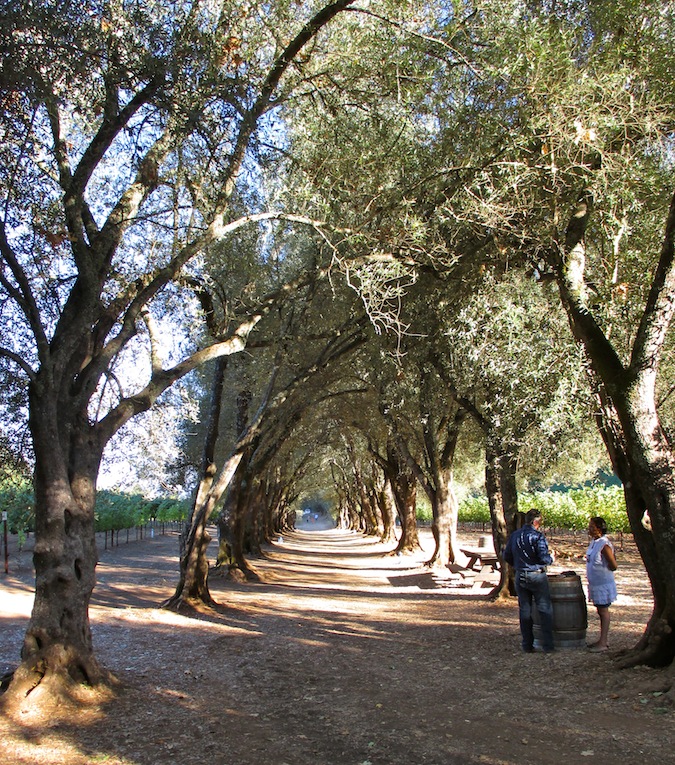 We arrived at the winery at sunset and followed an inviting path under a canopy of olive trees to a clearing where we were greeted by Hugh Davies, President and CEO of Schramsberg Vineyards. The welcome dinner took place in the J. Davies vineyard, named in honor of Hugh's father, Jack Davies, patriarch of the family who, with his wife Jamie, put Schramsberg Vineyards on the map as a world class sparkling wine house and ran it for over thirty years. The J. Davies vineyard is planted entirely to Cabernet Sauvignon from which the eponymous wine is made. We also had the pleasure of meeting Hugh's wife Monique (the two were married in this vineyard) as well as their three children who climbed trees and explored the vineyard while we sipped bubbly and got to know one another.We were welcomed with chilled flutes of Schramsberg's two single vineyard sparklers, the '08 Hyde Vineyards Napa Valley Carneros Brut and the '08 Jones Vineyard Napa Valley Carneros Brut. These delightful wines were perfect for quenching my thirst following a cross country flight and two hour drive up to wine country from San Francisco. They also paired beautifully with a variety of delicious hors d'oeuvres including Beef Tartare, Wild Salmon Crostini and, my personal favorite, Duck Confit "Chicken" Wings which provided a nice contrast to the crisp, sparkling wines. During the dinner we also had the chance to meet other key players at Schramsberg including Sparkling winemaker Keith Hock; Still Winemaker, Sean Thompson and Chef and Instructor for the weekend, the delightful Holly Peterson.
We arrived at the winery at sunset and followed an inviting path under a canopy of olive trees to a clearing where we were greeted by Hugh Davies, President and CEO of Schramsberg Vineyards. The welcome dinner took place in the J. Davies vineyard, named in honor of Hugh's father, Jack Davies, patriarch of the family who, with his wife Jamie, put Schramsberg Vineyards on the map as a world class sparkling wine house and ran it for over thirty years. The J. Davies vineyard is planted entirely to Cabernet Sauvignon from which the eponymous wine is made. We also had the pleasure of meeting Hugh's wife Monique (the two were married in this vineyard) as well as their three children who climbed trees and explored the vineyard while we sipped bubbly and got to know one another.We were welcomed with chilled flutes of Schramsberg's two single vineyard sparklers, the '08 Hyde Vineyards Napa Valley Carneros Brut and the '08 Jones Vineyard Napa Valley Carneros Brut. These delightful wines were perfect for quenching my thirst following a cross country flight and two hour drive up to wine country from San Francisco. They also paired beautifully with a variety of delicious hors d'oeuvres including Beef Tartare, Wild Salmon Crostini and, my personal favorite, Duck Confit "Chicken" Wings which provided a nice contrast to the crisp, sparkling wines. During the dinner we also had the chance to meet other key players at Schramsberg including Sparkling winemaker Keith Hock; Still Winemaker, Sean Thompson and Chef and Instructor for the weekend, the delightful Holly Peterson.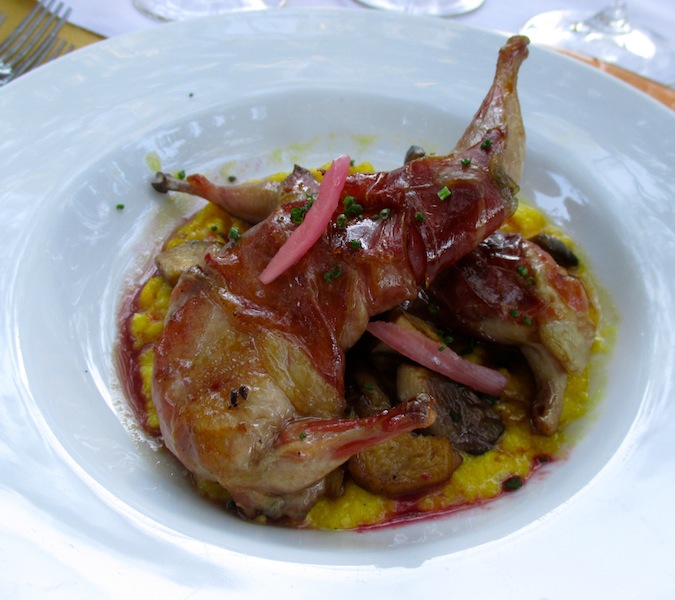 Once we were seated for dinner, the wine focus shifted to Schramsberg's still red wines, relatively new additions to the portfolio of this predominantly sparkling wine house. What better way to introduce them than to pair them with a delicious menu? The first course consisted of a beautiful La Quercia Speck Wrapped Quail with Creamed Corn, Trumpet Mushrooms and Pinot Noir Verjus paired with a duo of 2010 Davies single vineyard Pinot Noirs from the Londer Vineyard in Anderson Valley and the Nobles Vineyard from Sonoma Coast.The 2010 vintage represents the second vintage of the winery's still wines made from Pinot Noir. Both wines were lovely yet different: the Londer Vineyard Pinot was characterized by notes of ripe red and black fruit, licorice and spice while the Nobles Pinot exhibited notes of dried fruit and earth as well as firm tannins. Both wines paired nicely with the quail though I was partial to the Londer Vineyard Pinot with its plusher fruit and mild tannins.The main course of our vineyard dinner was a carnivore's dream featuring two different styles of succulent ribs: Slow Smoked Long Meadow Ranch Beef Ribs and Slow Smoked St. Louis Ribs with Memphis-style Barbeque Sauce, which ignited a rib rivalry among the Campers! I have to admit both types of ribs were mouth-wateringly delicious and paired well with the fruity and approachable 2009 J. Davies Cabernet Sauvignon from the Diamond Mountain District. My tablemates even made an agreement early on in the meal that it was perfectly acceptable to use our hands in lieu of utensils so we were all in virtual Hog Heaven - pun intended!
Once we were seated for dinner, the wine focus shifted to Schramsberg's still red wines, relatively new additions to the portfolio of this predominantly sparkling wine house. What better way to introduce them than to pair them with a delicious menu? The first course consisted of a beautiful La Quercia Speck Wrapped Quail with Creamed Corn, Trumpet Mushrooms and Pinot Noir Verjus paired with a duo of 2010 Davies single vineyard Pinot Noirs from the Londer Vineyard in Anderson Valley and the Nobles Vineyard from Sonoma Coast.The 2010 vintage represents the second vintage of the winery's still wines made from Pinot Noir. Both wines were lovely yet different: the Londer Vineyard Pinot was characterized by notes of ripe red and black fruit, licorice and spice while the Nobles Pinot exhibited notes of dried fruit and earth as well as firm tannins. Both wines paired nicely with the quail though I was partial to the Londer Vineyard Pinot with its plusher fruit and mild tannins.The main course of our vineyard dinner was a carnivore's dream featuring two different styles of succulent ribs: Slow Smoked Long Meadow Ranch Beef Ribs and Slow Smoked St. Louis Ribs with Memphis-style Barbeque Sauce, which ignited a rib rivalry among the Campers! I have to admit both types of ribs were mouth-wateringly delicious and paired well with the fruity and approachable 2009 J. Davies Cabernet Sauvignon from the Diamond Mountain District. My tablemates even made an agreement early on in the meal that it was perfectly acceptable to use our hands in lieu of utensils so we were all in virtual Hog Heaven - pun intended!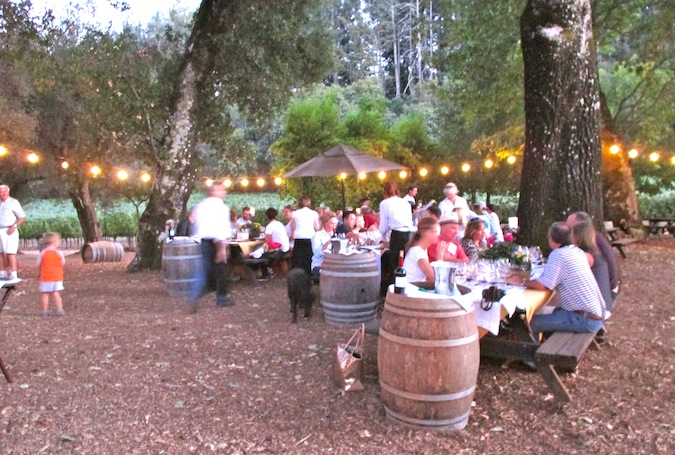 After our BBQ feast, we were treated to a cheese course featuring Fiscalini Cheddar, Point Reyes Toma and Shepherdista cheeses accompanied by black mission figs, apples and almonds. It was difficult not to consume all the delicious food and wine over the course of the evening, however, upon advice from Matt Levy, our fearless Camp Counselor, we were careful not to indulge too much in anticipation of the early morning ahead - buses were scheduled to leave Meadowood at 7:30am sharp. A good night's sleep was mandatory!
After our BBQ feast, we were treated to a cheese course featuring Fiscalini Cheddar, Point Reyes Toma and Shepherdista cheeses accompanied by black mission figs, apples and almonds. It was difficult not to consume all the delicious food and wine over the course of the evening, however, upon advice from Matt Levy, our fearless Camp Counselor, we were careful not to indulge too much in anticipation of the early morning ahead - buses were scheduled to leave Meadowood at 7:30am sharp. A good night's sleep was mandatory!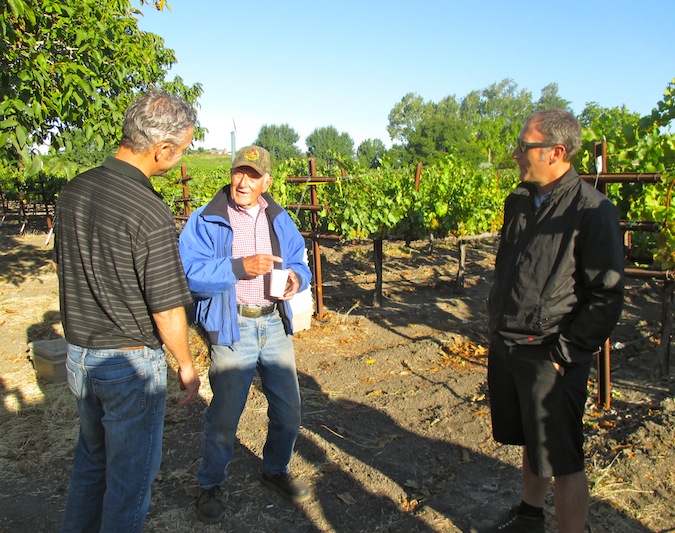 The next morning, we boarded the "Schramsberg Express" bus and headed towards Carneros. We were very fortunate to have Hugh Davies himself as our tour guide and enjoyed a 45-minute narrated drive to our destination getting the inside scoop on the beautiful landscape that unfolded before us. Highlights included the impact of the recent heat spike and its effect on various microclimates; who's Zinfandel vines were just being replanted; and the details of Jack and Jamie Davies' foray into the Cognac business with Remy Martin in the early days.Before we knew it we arrived at the Tognetti Vineyard where we were greeted by none other than Jack Tognetti himself, one of the spriest 90-something-year-olds I've ever met. He was joined by Schramsberg sparkling winemaker Keith Hock and Jaime, a Vineyard Manager who has been with Schramsberg since 1968!Jack Tognetti worked in the steamship business for twenty years but always thought of himself as a "farmer at heart." Tognetti purchased his vineyard and started planting Chardonnay grapes in 1980 and while he initially sold his grapes to the Swanson family, since 1998 he's been selling his Chardonnay exclusively to Schramsberg.He describes the climate as "cool and consistent: perfect for growing grapes for sparkling wine, " and about his working relationship with Schramsberg, "I try to give them nice fruit otherwise they bitch!" The vineyard produces approximately 80 tons of fruit consisting of a variety of clones including Monticello, the one we would be harvesting today. Beneath the vineyard soil is a pan of clay which is good at retaining water, making for very vigorous vines. The vines are grown on a quadrilateral trellis system and the grapes are picked between 17-21 Brix, the ideal range according to Keith Hock who gets a call from Tognetti at the appropriate time saying, "Keith, my damned vines are ready - pick 'em!"
The next morning, we boarded the "Schramsberg Express" bus and headed towards Carneros. We were very fortunate to have Hugh Davies himself as our tour guide and enjoyed a 45-minute narrated drive to our destination getting the inside scoop on the beautiful landscape that unfolded before us. Highlights included the impact of the recent heat spike and its effect on various microclimates; who's Zinfandel vines were just being replanted; and the details of Jack and Jamie Davies' foray into the Cognac business with Remy Martin in the early days.Before we knew it we arrived at the Tognetti Vineyard where we were greeted by none other than Jack Tognetti himself, one of the spriest 90-something-year-olds I've ever met. He was joined by Schramsberg sparkling winemaker Keith Hock and Jaime, a Vineyard Manager who has been with Schramsberg since 1968!Jack Tognetti worked in the steamship business for twenty years but always thought of himself as a "farmer at heart." Tognetti purchased his vineyard and started planting Chardonnay grapes in 1980 and while he initially sold his grapes to the Swanson family, since 1998 he's been selling his Chardonnay exclusively to Schramsberg.He describes the climate as "cool and consistent: perfect for growing grapes for sparkling wine, " and about his working relationship with Schramsberg, "I try to give them nice fruit otherwise they bitch!" The vineyard produces approximately 80 tons of fruit consisting of a variety of clones including Monticello, the one we would be harvesting today. Beneath the vineyard soil is a pan of clay which is good at retaining water, making for very vigorous vines. The vines are grown on a quadrilateral trellis system and the grapes are picked between 17-21 Brix, the ideal range according to Keith Hock who gets a call from Tognetti at the appropriate time saying, "Keith, my damned vines are ready - pick 'em!"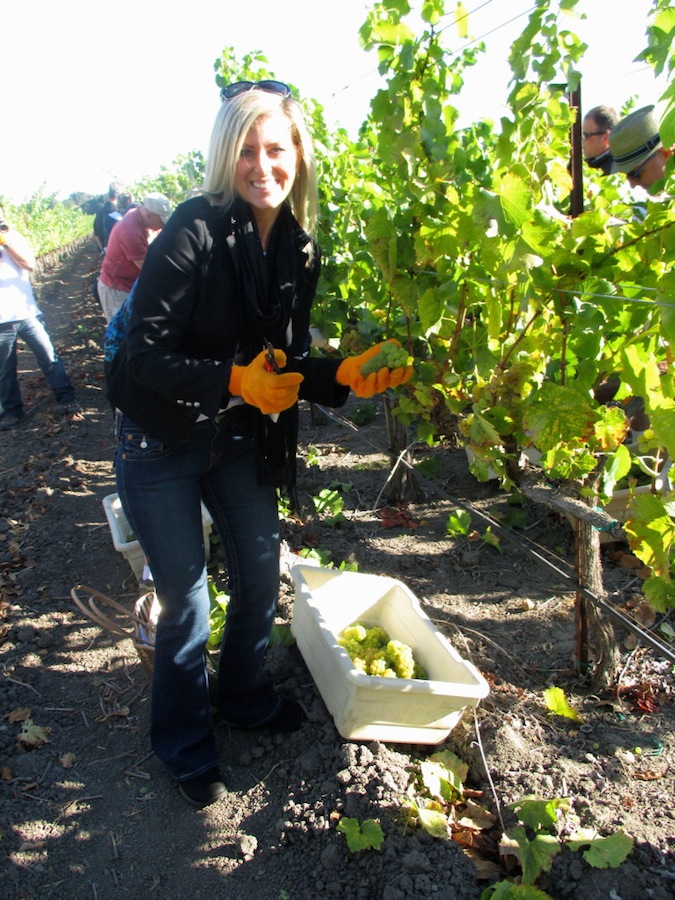 After our introduction to Jack and his vineyard we donned our gloves and grabbed our secateurs and headed down the vineyard rows, plastic bins in hand. Our challenge was to harvest as close to one ton of fruit as we could so everyone quickly got to work - no pressure!While initially unsure of exactly where to snip each cluster of grapes, with some instruction from Keith and Hugh I found my rhythm and was soon harvesting away. The clusters were large and heavy and the ripe Chardonnay grapes tasted like candy. Before I knew it, my bin was full and I just kept on harvesting until I had completed three whole bins. Everyone was really getting into the task at hand and before we knew it, all the grapes were harvested. The next step was to take the grapes we had freshly harvested back to the winery for pressing.
After our introduction to Jack and his vineyard we donned our gloves and grabbed our secateurs and headed down the vineyard rows, plastic bins in hand. Our challenge was to harvest as close to one ton of fruit as we could so everyone quickly got to work - no pressure!While initially unsure of exactly where to snip each cluster of grapes, with some instruction from Keith and Hugh I found my rhythm and was soon harvesting away. The clusters were large and heavy and the ripe Chardonnay grapes tasted like candy. Before I knew it, my bin was full and I just kept on harvesting until I had completed three whole bins. Everyone was really getting into the task at hand and before we knew it, all the grapes were harvested. The next step was to take the grapes we had freshly harvested back to the winery for pressing.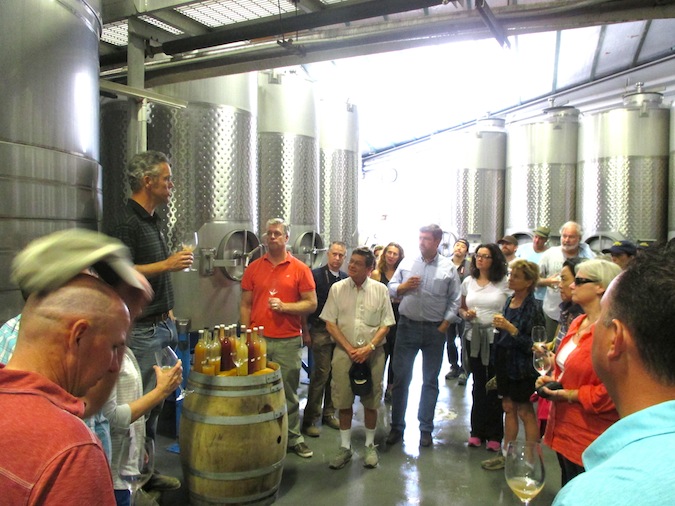 Back at Schramsberg, fueled by our success in the vineyard as well as the coffee and doughnut holes on the bus ride back, we were excited to taste the fruits of our labor. In addition to the freshly pressed juice from the Tognetti vineyard, which was sweet and grapey, we also tasted through a variety of wines in various states of fermentation.The samples in the bottles resembled murky, opaque lemonade, orange or cranberry juice and tasted like apples and citrus with yeasty overtones which we happily spat out onto the concrete floor. These wines were definitely not what you'd want to drink a whole glass of but a necessary step along the way to becoming a fabulous Schramsberg sparkler.First we tasted samples from the tanks and then from barrel, the latter being more bitter and difficult to tolerate and while unpleasant tasting, it was very interesting to experience the various stages of the fermentation process and experience first-hand the evolution of sparkling wine. Following the vinous assault on our palates, we were bussed off to Meadowood for lunch - the timing couldn't have been more perfect!
Back at Schramsberg, fueled by our success in the vineyard as well as the coffee and doughnut holes on the bus ride back, we were excited to taste the fruits of our labor. In addition to the freshly pressed juice from the Tognetti vineyard, which was sweet and grapey, we also tasted through a variety of wines in various states of fermentation.The samples in the bottles resembled murky, opaque lemonade, orange or cranberry juice and tasted like apples and citrus with yeasty overtones which we happily spat out onto the concrete floor. These wines were definitely not what you'd want to drink a whole glass of but a necessary step along the way to becoming a fabulous Schramsberg sparkler.First we tasted samples from the tanks and then from barrel, the latter being more bitter and difficult to tolerate and while unpleasant tasting, it was very interesting to experience the various stages of the fermentation process and experience first-hand the evolution of sparkling wine. Following the vinous assault on our palates, we were bussed off to Meadowood for lunch - the timing couldn't have been more perfect!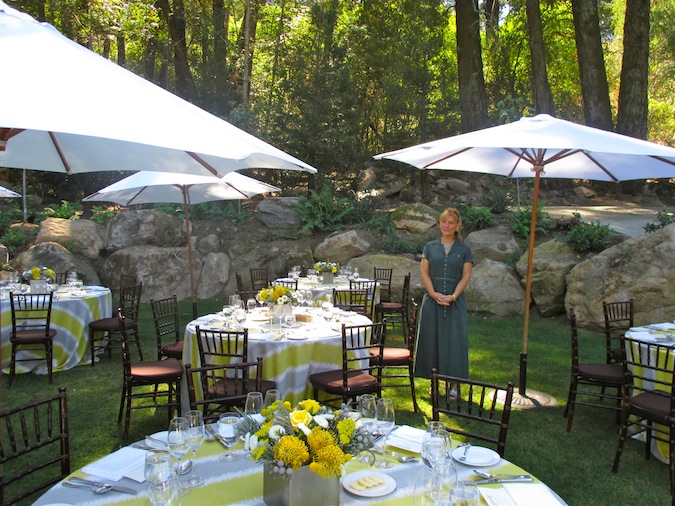 Waiting for us on the lawn at Meadowood was our Instructor for the rest of the afternoon, the delightful Holly Peterson, a renowned Chef who helped the Davies family conceive of and develop the Camp Schramsberg program 18 years ago.Peterson has quite an impressive resume including a degree in enology from the University of California, Davis and the Grand Diplome de Cuisine from the famed La Varenne Cooking School in France. She has shared her talent and passion for pairing food and wine in restaurants and venues around the world yet she and her family are very much a part of California wine history and community.Her father Richard Peterson is a California wine country pioneer and sister Heidi Peterson Barrett is a winemaker known for producing such well known California cult collectibles as Screaming Eagle, Dalla Valle and Paradigm to name a few.
Waiting for us on the lawn at Meadowood was our Instructor for the rest of the afternoon, the delightful Holly Peterson, a renowned Chef who helped the Davies family conceive of and develop the Camp Schramsberg program 18 years ago.Peterson has quite an impressive resume including a degree in enology from the University of California, Davis and the Grand Diplome de Cuisine from the famed La Varenne Cooking School in France. She has shared her talent and passion for pairing food and wine in restaurants and venues around the world yet she and her family are very much a part of California wine history and community.Her father Richard Peterson is a California wine country pioneer and sister Heidi Peterson Barrett is a winemaker known for producing such well known California cult collectibles as Screaming Eagle, Dalla Valle and Paradigm to name a few.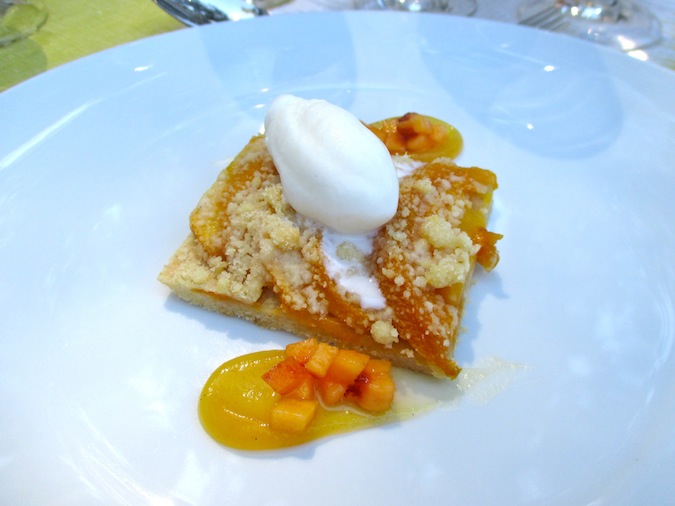 We sat down to a lovely three course lunch paired with Schramsberg's sparkling wines featuring Squash Consomme with Fresh Burrata, White Anchovies, Garden Herbs and Basil Blossoms paired with the 2005 J. Schram Rosé which continued to flow into the second course of Grilled Halibut with Roasted Baby Beets, Horseradish Creme Fraiche and Tempura Avocado. The rosé paired remarkably well with the various flavors and textures of the halibut dish especially the tempura avocado, the wine's natural acidity cutting through the rich, creamy texture. Our delightful lunch ended with one of my favorite pairings of the weekend: a Peach Cobbler with Anise Ice Cream paired with the 2008 Schramsberg Cremant Demi-Sec. The anise ice cream synergized with notes in the wine creating that elusive and oh so special 1+1=3 effect! Needless to say there's wasn't a crumb left on my plate.After our decadent, delicious lunch, we gathered around Peterson on the lawn as she taught us the art of sabrage, a technique for opening a bottle of Champagne using a sabre, a practice initially made famous by Napoleon who usually did so following a victory on the battlefield while on horseback. "The bottle consists of three components," Peterson instructed, "the two halves of the bottle and the collar, which sits on top of the neck of the bottle and holds the cork."She demonstrated the technique by holding a bottle of bubbly in one hand at a 45 degree angle with the seam facing up. Holding the sabre in the other hand, she ran the blade, tentatively at first, along the seam of the bottle then using enough force to hit the collar and cause the seam to "pop," shooting the collar off of the bottle in grand fashion with the cork still in it. Sounds easy enough, right? Actually it's not nearly as hard as it sounds or looks, you just need to "pop the seam," a phrase which would become our mantra as, one by one, each camper tried their hand at this age old tradition.
We sat down to a lovely three course lunch paired with Schramsberg's sparkling wines featuring Squash Consomme with Fresh Burrata, White Anchovies, Garden Herbs and Basil Blossoms paired with the 2005 J. Schram Rosé which continued to flow into the second course of Grilled Halibut with Roasted Baby Beets, Horseradish Creme Fraiche and Tempura Avocado. The rosé paired remarkably well with the various flavors and textures of the halibut dish especially the tempura avocado, the wine's natural acidity cutting through the rich, creamy texture. Our delightful lunch ended with one of my favorite pairings of the weekend: a Peach Cobbler with Anise Ice Cream paired with the 2008 Schramsberg Cremant Demi-Sec. The anise ice cream synergized with notes in the wine creating that elusive and oh so special 1+1=3 effect! Needless to say there's wasn't a crumb left on my plate.After our decadent, delicious lunch, we gathered around Peterson on the lawn as she taught us the art of sabrage, a technique for opening a bottle of Champagne using a sabre, a practice initially made famous by Napoleon who usually did so following a victory on the battlefield while on horseback. "The bottle consists of three components," Peterson instructed, "the two halves of the bottle and the collar, which sits on top of the neck of the bottle and holds the cork."She demonstrated the technique by holding a bottle of bubbly in one hand at a 45 degree angle with the seam facing up. Holding the sabre in the other hand, she ran the blade, tentatively at first, along the seam of the bottle then using enough force to hit the collar and cause the seam to "pop," shooting the collar off of the bottle in grand fashion with the cork still in it. Sounds easy enough, right? Actually it's not nearly as hard as it sounds or looks, you just need to "pop the seam," a phrase which would become our mantra as, one by one, each camper tried their hand at this age old tradition.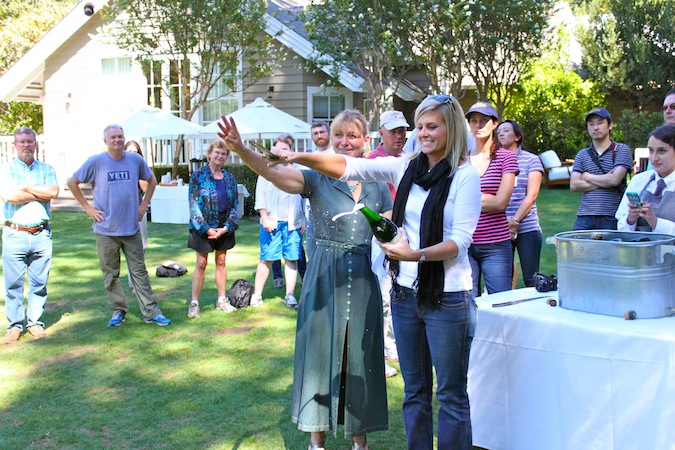 Peterson offered us two weapons of choice to practice our sabering skills, a Laguiole Champagne sabre as well as a genuine antique sabre she procured from a French vintage shop that looked as if it may have belonged to Napoleon himself! As a practitioner of sabrage with my own Laguiole sabre at home, I looked forward to using the vintage saber when it came time to decapitate my bottle.It was quite heavy and much larger than the sabre I was used to using and as I grasped it I had a fleeting feeling of being on the battlefield then realized I'd much rather be on the lawn at Meadowood about to open a bottle of sparkling wine. The larger sabre made the process much easier due to its weight and momentum and before I knew it, the cork was shooting across the lawn and I was victorious!
Peterson offered us two weapons of choice to practice our sabering skills, a Laguiole Champagne sabre as well as a genuine antique sabre she procured from a French vintage shop that looked as if it may have belonged to Napoleon himself! As a practitioner of sabrage with my own Laguiole sabre at home, I looked forward to using the vintage saber when it came time to decapitate my bottle.It was quite heavy and much larger than the sabre I was used to using and as I grasped it I had a fleeting feeling of being on the battlefield then realized I'd much rather be on the lawn at Meadowood about to open a bottle of sparkling wine. The larger sabre made the process much easier due to its weight and momentum and before I knew it, the cork was shooting across the lawn and I was victorious!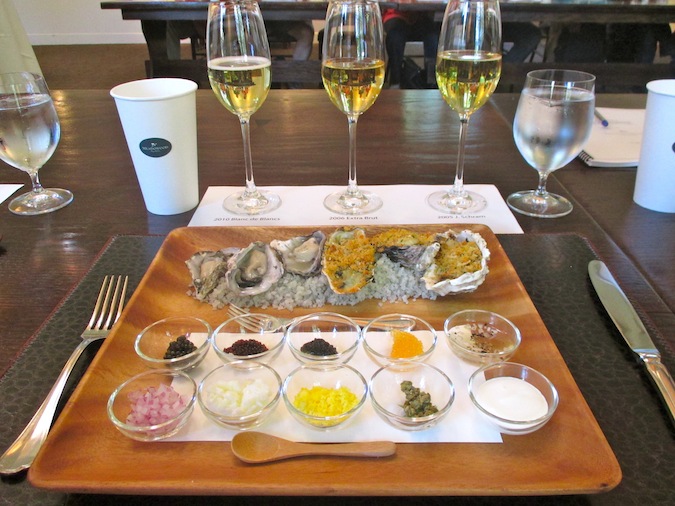 We finished the day with a lesson on pairing sparkling wine with food, focusing on "The Classics." On the tasting mats before us were three glasses of Schramsberg bubbly: the 2010 Blanc de Blancs, 2006 Extra Brut and the 2005 J. Schram. Peterson guided us through a tasting of the sparkling wines and we acquainted ourselves with the nuances of each one before any food was introduced. After this arduous task we were presented with a platter of delightful selections from the sea to pair with the sparklers including raw oysters, Oysters Rockefeller and a selection of caviar and associated accoutrements.Over the remainder of the day we experimented with various pairing combinations, challenging some conventionally held beliefs and discovering some new favorites. The raw oysters (Miyagi oysters from the Pacific Northwest) with mignonette were brilliant paired with the 2010 Blanc de Blancs as one might expect. The Oyster Rockefeller on the other hand paired best with the 2005 J. Schram, the Schramsberg tête de cuvée, with its rich, nutty profile. The caviar pairings also revealed some surprises such as the significant difference the toppings make. Truffled Tiger-Eye Whitefish Roe topped with egg yolk was utterly delicious when paired with the 2006 Extra Brut; however, when the yolk was swapped for egg white the result was nowhere near as pleasing. By the end of the seminar we had experimented with a variety of options and learned a lot about the nuances of creating the "perfect pairing."As our first day of Camp drew to a close, we were blissfully weary from all the harvesting, sabrage and sparkling wine and food pairing (can you hear the violins?). The day was not entirely done, however, because just a few short hours after our last class was over the Schramsberg Library Wine Dinner would begin and you know there's no way I was going to miss that! Stay tuned for "Part Two" of my Camp Schramsberg adventures.Cheers,
We finished the day with a lesson on pairing sparkling wine with food, focusing on "The Classics." On the tasting mats before us were three glasses of Schramsberg bubbly: the 2010 Blanc de Blancs, 2006 Extra Brut and the 2005 J. Schram. Peterson guided us through a tasting of the sparkling wines and we acquainted ourselves with the nuances of each one before any food was introduced. After this arduous task we were presented with a platter of delightful selections from the sea to pair with the sparklers including raw oysters, Oysters Rockefeller and a selection of caviar and associated accoutrements.Over the remainder of the day we experimented with various pairing combinations, challenging some conventionally held beliefs and discovering some new favorites. The raw oysters (Miyagi oysters from the Pacific Northwest) with mignonette were brilliant paired with the 2010 Blanc de Blancs as one might expect. The Oyster Rockefeller on the other hand paired best with the 2005 J. Schram, the Schramsberg tête de cuvée, with its rich, nutty profile. The caviar pairings also revealed some surprises such as the significant difference the toppings make. Truffled Tiger-Eye Whitefish Roe topped with egg yolk was utterly delicious when paired with the 2006 Extra Brut; however, when the yolk was swapped for egg white the result was nowhere near as pleasing. By the end of the seminar we had experimented with a variety of options and learned a lot about the nuances of creating the "perfect pairing."As our first day of Camp drew to a close, we were blissfully weary from all the harvesting, sabrage and sparkling wine and food pairing (can you hear the violins?). The day was not entirely done, however, because just a few short hours after our last class was over the Schramsberg Library Wine Dinner would begin and you know there's no way I was going to miss that! Stay tuned for "Part Two" of my Camp Schramsberg adventures.Cheers,
